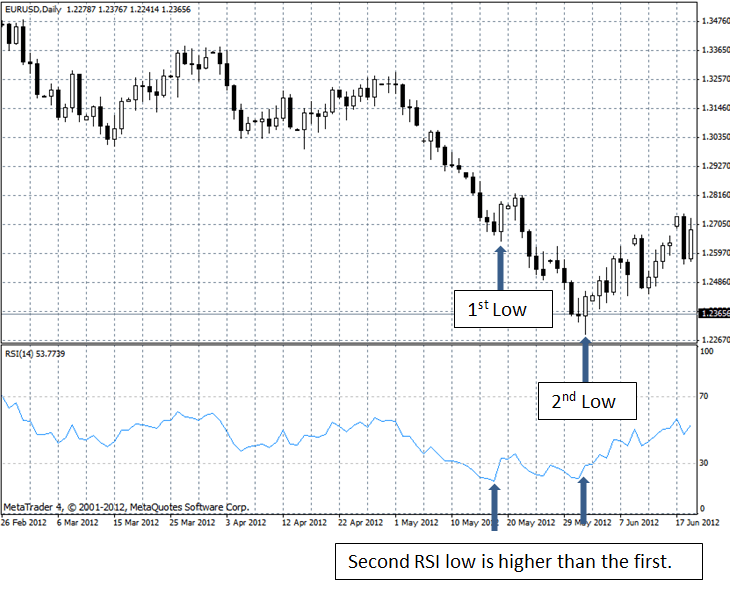J. Welles Wilder initially introduced the Relative Strength Index in 1978 in the book New Concepts in Technical Trading Systems. The indicator has since become one of the most popular ways for binary option traders to determine whether a market is overbought or oversold and is a vital component of many technical trading systems.
Typically abbreviated RSI, the Relative Strength Index is a bounded oscillator that gives readings between zero and 100. Although most technical analysis systems will allow you to change the number of periods used to compute the RSI, Wilder specifically recommended using 14 periods for this parameter.
Guest Post by Jay Hawk from BinaryOptionsNow.com
When this popular technical indicator reads below 30, the market is considered oversold and conditions may be ripe for a correction higher. Conversely, when the RSI reads over 70, the market is considered overbought and may indicate conditions where a corrective decline could be expected.
Many swing traders use the RSI to indicate when the market may be due for a reversal in direction.
Trading RSI Signals Using Binary Options
The simplest way to use the RSI as a binary options trading signal would be to observe when a market with an RSI in an extreme overbought or oversold condition moves back into RSI-neutral territory between readings of 30 or 70.
For example, if the RSI was in overbought territory above 70 and then dropped below 70, this would be a bearish signal. Such a signal would indicate conditions might be suitable to purchase a binary put option on the underlying asset or currency pair.
Alternatively, if the RSI was in oversold territory below 30 and then rose above the 30 level, this would be a bullish signal. Such a signal would indicate conditions might be suitable to purchase a binary call option on the underlying asset or currency pair.
A more complex RSI trading method involves looking for divergence between price extremes and the levels observed on the RSI at the same times, especially when such divergence occurs outside of neutral RSI territory that is located between RSI readings of 30 and 70.
Trading Bullish RSI Divergence Signals Using Binary Options
Regular bullish divergence is noted on a chart when the underlying asset’s price or the currency pair’s exchange rate makes a new low for a period, but the RSI fails to confirm it by also making a new low. Instead the RSI’s level for that period does not make a new low.
If this sort of divergence occurs when the RSI is reading in oversold territory below the 30 level, then it is considered a strong and fairly reliable bullish signal.
Binary option traders observing such bullish price-RSI divergence could use it as a signal to establish a long binary call position on the underlying. If they are only mildly bullish, then they could purchase an at the money call binary option, while a strongly bullish view would suggest buying a greater amount of out of the money binary call options to increase their leverage.
Trading Bearish RSI Divergence Signals Using Binary Options
Regular bearish divergence is noted on a chart when the underlying asset’s price or the currency pair’s exchange rate makes a new high, but the RSI fails to confirm it by also making a new high. Instead the RSI’s level for that period does not make a new high.
If this sort of divergence occurs when the RSI is reading in overbought territory above the 70 level, then it is considered a strong and fairly reliable bearish signal.
Binary option traders observing such bearish price-RSI divergence could use it as a signal to establish a long binary put position on the underlying. If they are only mildly bearish, then they could purchase an at the money put binary option, while a strongly bearish view would suggest buying a greater amount of out of the money binary put options to increase their leverage.
Example of a Bullish RSI Trading Signal in EUR/USD
The daily candlestick chart below shows the 14-day Relative Strength Index or RSI in pale blue in the indicator box below the exchange rate for the EUR/USD currency pair. Binary option traders could watch such a chart for regular RSI-exchange rate divergence that occurs in extreme territory.
To facilitate making this analysis visually, horizontal lines are drawn in the RSI indicator box to show where overbought territory lies at RSI readings greater than 70 and where oversold levels are located at RSI readings less than 30.
The EUR/USD chart below also illustrates an example of regular bullish divergence where the exchange rate made a series of two significant low points within an overall downwards trend. Nevertheless, the RSI was in oversold territory at both of those points, and it failed to make a fresh low when the second low was observed in the EUR/USD exchange rate.
This regular bullish divergence signaled that the market in EUR/USD was ripe for an upward correction. After the second RSI low was observed at a higher level than the first, that would have been an excellent time for a trader to have purchased an At-the-Money binary call option expiring in one or two weeks’ time.
As the chart illustrates, the EUR/USD exchange rate then corrected sharply upward, as would have been expected. The trader could then choose to exercise their now In-the-Money binary call option or could sell it back, if the option was not yet due to expire.

